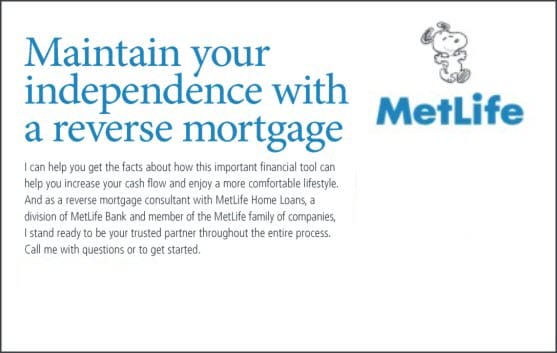
America’s #1 Rated Reverse Lender

 |
ARLO™REVERSE MORTGAGE
ASSISTANT |
MetLife Reverse Mortgage Review (2023 Update)
 |
Michael G. Branson, CEO of All Reverse Mortgage, Inc., and moderator of ARLO™, has 45 years of experience in the mortgage banking industry. He has devoted the past 20 years to reverse mortgages exclusively. (License: NMLS# 14040) |
 |
All Reverse Mortgage's editing process includes rigorous fact-checking led by industry experts to ensure all content is accurate and current. This article has been reviewed, edited, and fact-checked by Cliff Auerswald, President and co-creator of ARLO™. (License: NMLS# 14041) |
Today, most reverse mortgages are closed by non-bank mortgage lenders across the U.S. But going back a few years, most reverse mortgage volume was conducted by big, national banks. Among those lenders was MetLife Bank, which used to be operated by the large national insurance provider MetLife.
In fact, at one time, MetLife was the largest Home Equity Conversion Mortgage (HECM) lender by volume, prior to exiting the business in 2012. If you know someone who has a reverse mortgage today, it’s very possible that he or she worked with MetLife on that loan.

Summary:
- MetLife Bank, operated by national insurer MetLife, at one time was the top lender by volume in the Home Equity Conversion Mortgage (HECM) market
- MetLife exited the reverse mortgage originations business in April 2012
- Today, there are many remaining non-bank lenders and small banks that continue to offer reverse mortgages
MetLife ramped up its reverse mortgage presence following its acquisition of EverBank Reverse Mortgage in 2008.
At that time, the bank’s president noted that the transaction would “enhance MetLife’s capabilities to help consumers meet their needs for a secure retirement.” Over the next four years, the company rose to the top position for reverse mortgage closings, closing more than 900 reverse mortgages in April 2012.
MetLife Pros and Cons
PROS CONS
Recognizable brand (Snoopy) is amongst the largest global providers of insurance in the US Sold reverse mortgage servicing portfolio to Champion Mortgage and no longer services the loans they originated
145 Years in Business MetLife Bank, N.A.'s sold deposit business to GE Capital Retail Bank in 2013
62 billion in annual revenue No longer provides reverse mortgage lending services
MetLife Reverse Mortgages Originated
MetLife HECM ENDORSEMENT SUMMARY REPORT BY LENDER ACTIVITY
Year Loans National Market Share
2008 161 112,154 .01%
2009 2,452 114,692 2%
2010 3,443 79,106 4%
2011 8,523 73,131 12%
2012 10,287 54,822 19%
Source: https://apps.hud.gov/pub/chums/f17fvc/hecm.cfm
Why did MetLife quit reverse mortgages?
MetLife’s decision to exit the reverse mortgage came on the heels of similar announcements from other large, national lenders, including Bank of America and Wells Fargo. When the company announced its exit, it cited the fact that MetLife’s banking business comprised just a small fraction of the company’s operations, and that the reverse mortgage business no longer made sense.
Industry publication Reverse Mortgage Daily also learned at the time that the regulatory environment at the time made it difficult for the bank to operate various channels. Prior to its reverse mortgage exit, MetLife made other changes to a similar effect: it sold its depository bank business to GE Capital Financial Inc. in 2011, wound down its forward mortgage business in 2012 and finally announced it had agreed to sell its warehouse finance unit, including its reverse mortgage warehouse lines, also in early 2012.
Market timeline leading up to MetLife exit in 2012:
- December 2007 — Great Recession begins with market crash and multi-trillion-dollar impact to the U.S. housing market
- July 2010 — The Dodd–Frank Wall Street Reform and Consumer Protection Act is enacted, changing the landscape for banking regulation
- February 2011 — Bank of America exits reverse mortgages
- June 2011 — Wells Fargo exits retail reverse mortgage business and later wholesale
What about existing borrowers?
MetLife ultimately sold its loan servicing business to Nationstar, which later changed its company name to Mr. Cooper. Mr. Cooper continues to service reverse mortgage loans through Champion Mortgage and most likely is managing the servicing for borrowers who got reverse mortgages through MetLife prior to its exit from the business.
Will MetLife Bring Back Reverse Mortgages?
Given that MetLife is no longer in the banking business, it is unlikely — although not impossible — that MetLife will get back into reverse mortgages. However, MetLife continues to offer many products including insurance products and employment benefits.
There are also many active lenders still offering reverse mortgages. Some of the non-bank lenders include All Reverse Mortgage Inc., AAG, Finance of America Reverse and Reverse Mortgage Funding. There are also many existing banks in the reverse mortgage space today; they tend to be regional banks or small national banks with a federal charter. Banks such as M&T Bank, Quontic Bank, Magnolia Bank and Resolute Bank, among many others, continue to offer reverse mortgages.
Where to Get a Reverse Mortgage
There are many active lenders in the reverse mortgage space today — including both banks and non-bank lenders — as well as brokers who can help prospective borrowers navigate the different loan options and interest rates that are available.
A good place to begin is gathering a few pieces of information including your age (and the age of your spouse, if you are married), and your home address so that a reverse mortgage calculator can give a rough estimate of the amount you may be able to borrow.
Visit ARLO, the All Reverse Loan Optimizer, to help you get started.

Have a Question About Reverse Mortgages?
Over 2000 of your questions answered by ARLO™
Ask your question now!

 Michael G. Branson
Michael G. Branson Cliff Auerswald
Cliff Auerswald


September 17th, 2019
September 23rd, 2019